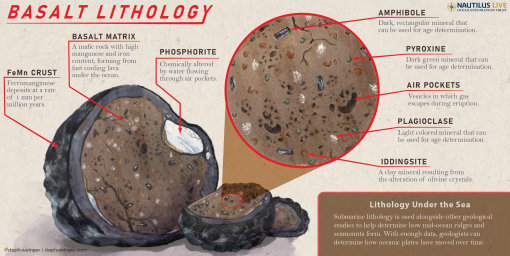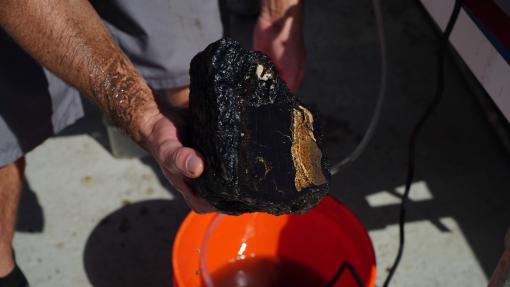The Science of Lithology: Dating the Seafloor’s Movements Over Time

This blog was written by Stephanie Weinger.
Over millions of years, our planet’s ocean plates have moved, morphed, and evolved through volcanic and tectonic activity. To tell both the prehistoric and modern stories of the seafloor, scientists turn to geological samples – also known as rocks. In particular, lithology, or the study of the general physical characteristics of rocks, allows geologists to peer through history simply by slicing a rock in two.

Geologists onboard E/V Nautilus employ ROV Hercules to collect rocks from the seafloor to learn more about these unique and poorly understood remote marine environments. Certain characteristics – such as a rock’s color, texture, and mineralogy – allow scientists to date a particular sample. By sampling rocks from various depths along a seamount, a geologist can use the collective data to form theories on how the seamount structure formed.

Many oceanographic volcanic, or mafic, rocks are comprised of basalt, a black-hued rock created when hot lava cools rapidly. Basalt rocks are distinguishable in that they contain high levels of manganese and iron and low silica concentrations. They are often observed with an exterior coating of ferromanganese deposits.

When a scientist slices a basalt rock, they often will see two distinct layers, the outer layer being the ferromanganese (FeMn) crust, which appears black, and a lighter brown basalt layer contained inside. As observed during the NA153 Nautilus cruise, Deep Sea Biodiversity & Ancient Seamount Exploration near Johnston Atoll, cross-sections of geological samples revealed small pore-like holes, which are remnants of air pockets where volcanic gases escaped during eruption (aka the process in which crystal nuclei form and grow at high temperatures).
As basalt forms over time, water filtering through these pockets may chemically alter the rock to cause a build-up of a type of sedimentary rock known as phosphorite. Speckled mineral crystals seen in basalt cross-sections can be used to determine the age of the rock, particularly minerals like amphibole, pyroxene, plagioclase and olivine, and iddingsite.
Simply put, lithology is the identification of rocks. It is the first step in the scientific understanding of dating seafloor features and, when paired with other geological practices, helps scientists to better illustrate the story of seafloor formation.
